This page contains the detailed and easy notes for GCSE OCR Biology coordination and Control-The endocrine System for revision and understanding coordination and Control-The endocrine System .
GCSE OCR GATEWAY Biology Complete Revision Summary
Coordination and control – The endocrine system
HORMONAL CONTROL
- Human endocrine system
Negative feedback systems in hormonal control – Higher
Thyroxine and adrenaline – Higher
Hormones and puberty
The menstrual cycle
Hormonal methods of contraception
Non-hormonal methods of contraception
Hormones used in reproductive technology to treat infertility – Higher
Evaluating infertility treatments – Higher
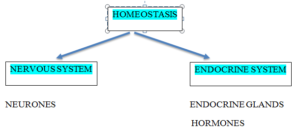
HORMONAL and NERVOUS SYSTEM
Hormones
- They are chemical messenger secreted by the endocrine glands
- they are secreted in the blood and travel to the target organ
- Target organ has receptors and hormones
- bind to the receptor and triggers a response
- It produces a slower but long term response
Nervous System
- Is the system of neurones which send electrical impulses to produce a response
- The message is transmitted via electrical impulses
- The response produced is localised and impulses do not travel large distances
- It produces quick but short term response
Baneer 6
PITUITARY : THE MASTER GLAND – Smallest endocrine gland of the body. It is pea shaped, ovoid, reddish brown gland situated at base of the brain in cavity, sella turcica of sphenoid bone. It controls almost all endocrine glands. Hence it is also called master gland
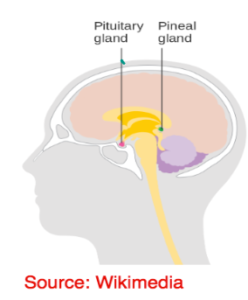
- Master Gland
- It controls other glands of the body
- Follicle Stimulating Hormone
- Antidiuretic Hormone
- Thyroid Stimulating Hormones
EXAMPLES
| GLAND | HORMONE | TARGET ORGAN | EFFECT |
| Pituitary | Follicle stimulating hormone (FSH) Thyroid stimulating hormone (TSH) Anti-diuretic hormone (ADH) | Ovaries Thyroid Gland Kidneys | make the female sex hormones estrogen stimulate the gland to release thyroxine which control metabolism controls the water level by causing reabsorption of water |
| Thyroid Gland | Thyroxine | Liver and Kidneys | Controls the metabolism |
| Adrenal Gland | Adrenaline | Liver and Heart | prepares for fight and flight |
| Testes | Testosterone | Male reproductive organs | Developes secondary sexual characterstics |
| Pancreas- | Insulin Glucagon | Liver Liver | Decreases blood glucose levels Increases blood glucose levels |
| Ovaries | Oestrogen Progesterones | Female reproductive organs | Controls the development of egg, menstural cycle and develop secondary sexual characteristics. |
Banner 7
_The endocrine system__
[download_after_email id="9127"]
CONTROL OF BLOOD GLUCOSE
- Pancreas Insulin and Glucagon (lowers the blood glucose level)
- Increases the blood glucose level)
- Insulin Effect
- It increases the permeability of cells to glucose
- It converts excess glucose to -glycogen
- It converts excess glucose to fats
- It stops the breakdown of fats
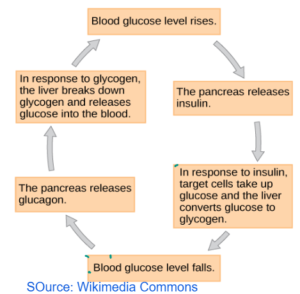
Glucagon 'is the hormone
Glycogen is the stored carbohydrate
DIABETES
| TYPE 1 | TYPE 2 |
| Insulin dependent | Insuline independent |
| Body does not produce insulin | Body is resistance to insulin |
| Caused by damage to pancreas | Caused by poor lifestyle and diet |
| Treated with insulin injections | Treated with lifestyle changes |
| Most common in young age | Common in obese people |
| It can be genetic. | It is mostly environmental. |
| Drugs might not be required | Drugs are given to make body to respond to insulin |
DIABETES TREATMENT
TYPE 1
- Insulin injections directly into the blood stream.
- Less taken orally as being a protein hormone it can get digested by stomach.
- The insulin converts excess glucose into glycogen and control the blood glucose level.
- Less intake of carbohydrates.
- Pancreatic Transplant
- Pancreatic Cell Transplant
- Using stem cells to regenerate pancreatic cells.
TYPE 2
- Balanced diet
- Regular Exercise
- Weight Management
- Drug to increase sensitivity of pancreas to insulin
- Insulin injections to increase the concentration of insulin to make them more responsive to insulin.
NEGATIVE FEEDBACK
- When the level of anything rises above optimum like glucose concentration, water concentration or temperature negative feedback decreases it
- When the level of anything decreases below optimum the negative feedback raises it.
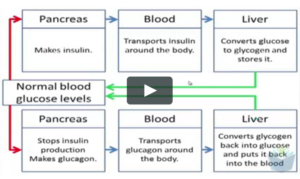
FIGHT OR FLIGHT HORMONE
- Stress Hormone
- Increase heart rate
- Increase breathing rate
- Dilate the pupil

Emergency Hormones
- Increase Blood Flow
- Increase the flow of oxygen to the brain
- Divert blood flow away from the gut
HUMAN REPRODUCTIVE SYSTEM
TESTOSTERONE
Male hormone responsible for secondary sexual characters
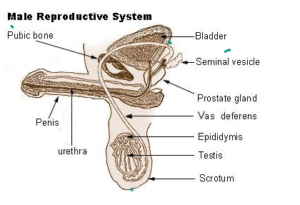
OESTROGEN
Female hormone responsible for secondary sexual characters
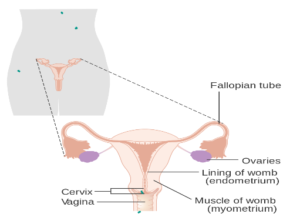
MENSTURATION CYCLE
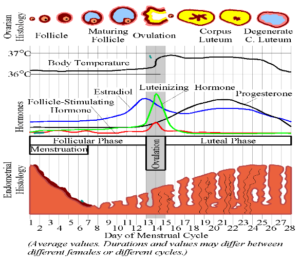
| Days | Phase | Development |
| Day 1- Day 4 | Mensturation | Shedding of the uterus linning along with the egg. Progesterone falls |
| Day 5- Day 14 | Follicular Phase | Egg is matured in the ovary. Increase in FSH |
| Day 14 | Ovulation | Egg is released. Caused by Lutenizing Hormone |
| Day 14-Day 28 | Luteal Phase | Increase in progesterone and oestrogen which maintains the uterus linning and wait for eggs to fertilize. If not fertilize in next 14 days linning breaks. |
HORMONES OF MENSTURATION
| Hormone | Gland | Effective Days | Effect |
| Follicle Stimulating Hormone (FSH) | Pituitary | Day I-Day 14 | Maturation of egg in the follicle. Stimulate the production of Oestrogen |
| Lutenizing Hormone (LH) | Pituitary | Day 14 | Cause Ovulation |
| Oestrogen | Ovaries | Day 14-Day 28 | Develops uterus lining. Stimulates LH and inhibit FSH |
| Progesterone | Empty egg follicle in the ovaries | Day 14- Day 28 | Maintains linning of uterus and prepare for pregnancy. Inhibits both LH and FSH So no mensturatlon happen during pregnancy. |
CONTRACEPTION METHODS
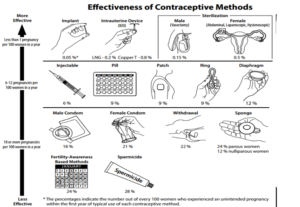
Preventing Sperms to reach the egg. Preventing the implantation of the zygote in the uterus.
Barrier Methods: Prevent the sperm to meet the eggs
Hormonal Methods: Prevents the eggs to mature or prevent the implantation of eggs in the uterus.
Chemical Methods: Kills the sperm
Intrauterine Device: Prevent embryo from implanting
Surgical Method: It is permanent contraception
HOW CONTRACEPTION WORKS?
Contraceptive Pills
- They contain the mix of female hormones oestrogen and progesterone. -MIX PILL
- Prevent the release of FSH preventing the maturation of eggs
- Make thick mucus in the cervix to prevent the entry of sperms.
- Prevent the uterus linning development, preventing implantation.
- Some pills are progesterone only pills.
- A contraceptive implant is also inserted which slowly release progesterone in the uterus.
- A contraceptive patch also absorbs the mix of hormones into the blood
- Side Effects: blood pressure, has to be taken daily changes in menstural pattern
Contraceptive Pills
- They contain the mix of female hormones oestrogen and progesterone. -MIX PILL
- Prevent the release of FSH preventing the maturation of eggs
- Make thick mucus in the cervix to prevent the entry of sperms.
- Prevent the uterus linning development, preventing implantation.
- Some pills are progesterone only pills.
- A contraceptive implant is also inserted which slowly release progesterone in the uterus.
- A contraceptive patch also absorbs the mix of hormones into the blood
- Side Effects: blood pressure, has to be taken daily changes in menstural pattern
Intra Uterine Device
- Copper T is inserted into the uterus
- It releases copper ions which are toxic to sperms
- The device also prevent the implanting of the embryo into the uterus
- Some releases progesterones which works the same like contraceptive pills
- Prevent the release of FSH preventing the maturation of eggs
- Make thick mucus in the cervix to prevent the entry of sperms.
- Prevent the uterus linning development, preventing implantatiom
- Side Effects: Infection; Internal Bleeding
Surgical Methods
VASECTOMY: Male Sterlization
- Sperms ducts are cut and sealed so that the sperms cannot enter the urethra preventing fertilization.
TUBECTOMY: Femal Sterlization
- The oviducts are cut and tied to prevent the release of egg which prevent
- Sterlizatlom
- Side Effects - It is permanent.
INFERTILITY PROBLEMS
OVULATION PROBLEM
- The eggs do not mature or problem ovulating.
- The women is given fertility drugs which are the mix of FSH and LH that stimulated maturation and ovulation
FAULTY TUBES
IMPLANTATION
- In Vitro Fertilization where fertilization is performed in the laboratory and the embryo is implanted back in the uterus for the development
PREGNANCY DEVELOPMENT
- Surrogate Mother where the fertilized egg is implanted into another mother who gives birth
IN VITRO FERTILIZATION
- Expensive
- Results in multiple embryos
- Premature births
- Birth with disability
- Not always successful
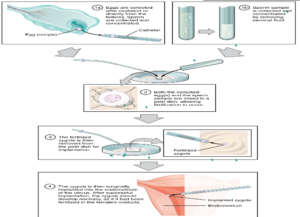
Fertility drugs to stimulate ovulation
Ovary and sperm are collected to perform fertilization.
Fertilized egg is developed in the laboratory giving suitable conditions to develop into an embryo.
Embryo is inserted into the uterus
Develops into a baby.
Disclaimer:
I have tried my level best to cover the maximum of your specification. But this is not the alternative to the textbook. You should cover the specification or the textbook thoroughly. This is the quick revision to help you cover the gist of everything. In case you spot any errors then do let us know and we will rectify it.
References:
BBC Bitesize
Wikipedia
Wikimedia Commons
Image Source:
Wikipedia
Wikimedia
Commons
Flickr
Pixabay
Make sure you have watched the above videos and are familiar with the key definitions before trying these questions. It is also good to time yourself while doing these questions so that you can work on the speed as well
Human Nervous System
- Human Nervous System 1 MS
- Human Nervous System 1 QP
- Human Nervous System 2 MS
- Human Nervous System 2 QP
- Human Nervous System 3 MS
- Human Nervous System 3 QP
